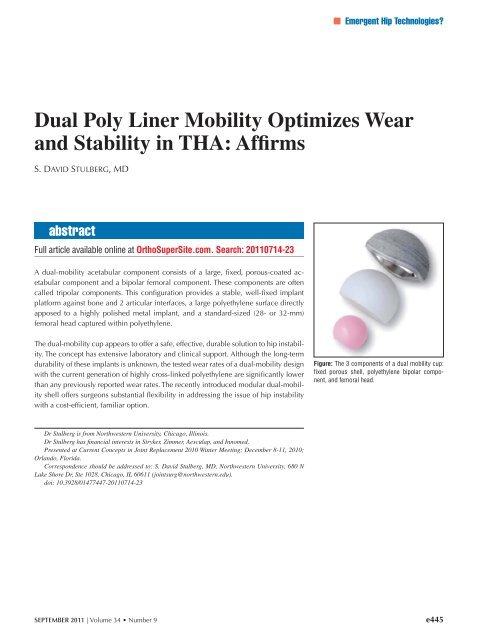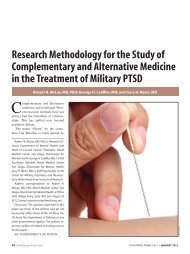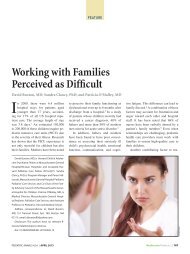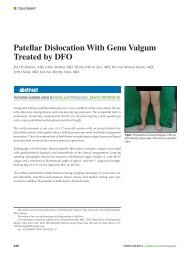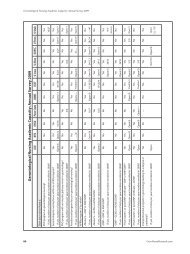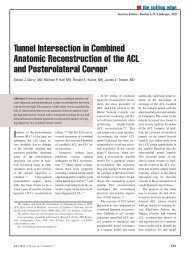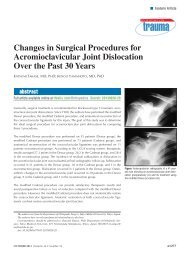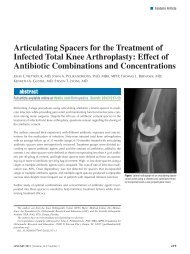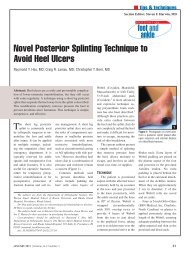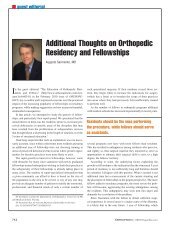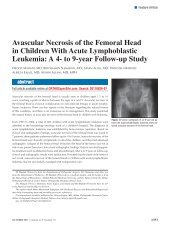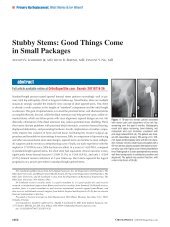Dual Poly Liner Mobility Optimizes Wear and Stability in THA - Healio
Dual Poly Liner Mobility Optimizes Wear and Stability in THA - Healio
Dual Poly Liner Mobility Optimizes Wear and Stability in THA - Healio
Create successful ePaper yourself
Turn your PDF publications into a flip-book with our unique Google optimized e-Paper software.
■ Emergent Hip Technologies?<br />
<strong>Dual</strong> <strong>Poly</strong> <strong>L<strong>in</strong>er</strong> <strong>Mobility</strong> <strong>Optimizes</strong> <strong>Wear</strong><br />
<strong>and</strong> <strong>Stability</strong> <strong>in</strong> <strong>THA</strong>: Affirms<br />
S. DAVID STULBERG, MD<br />
abstract<br />
Full article available onl<strong>in</strong>e at OrthoSuperSite.com. Search: 20110714-23<br />
A dual-mobility acetabular component consists of a large, fixed, porous-coated acetabular<br />
component <strong>and</strong> a bipolar femoral component. These components are often<br />
called tripolar components. This configuration provides a stable, well-fixed implant<br />
platform aga<strong>in</strong>st bone <strong>and</strong> 2 articular <strong>in</strong>terfaces, a large polyethylene surface directly<br />
apposed to a highly polished metal implant, <strong>and</strong> a st<strong>and</strong>ard-sized (28- or 32-mm)<br />
femoral head captured with<strong>in</strong> polyethylene.<br />
The dual-mobility cup appears to offer a safe, effective, durable solution to hip <strong>in</strong>stability.<br />
The concept has extensive laboratory <strong>and</strong> cl<strong>in</strong>ical support. Although the long-term<br />
durability of these implants is unknown, the tested wear rates of a dual-mobility design<br />
with the current generation of highly cross-l<strong>in</strong>ked polyethylene are significantly lower<br />
than any previously reported wear rates. The recently <strong>in</strong>troduced modular dual-mobility<br />
shell offers surgeons substantial flexibility <strong>in</strong> address<strong>in</strong>g the issue of hip <strong>in</strong>stability<br />
with a cost-efficient, familiar option.<br />
Figure: The 3 components of a dual mobility cup:<br />
fi xed porous shell, polyethylene bipolar component,<br />
<strong>and</strong> femoral head.<br />
Dr Stulberg is from Northwestern University, Chicago, Ill<strong>in</strong>ois.<br />
Dr Stulberg has fi nancial <strong>in</strong>terests <strong>in</strong> Stryker, Zimmer, Aesculap, <strong>and</strong> Innomed.<br />
Presented at Current Concepts <strong>in</strong> Jo<strong>in</strong>t Replacement 2010 W<strong>in</strong>ter Meet<strong>in</strong>g; December 8-11, 2010;<br />
Orl<strong>and</strong>o, Florida.<br />
Correspondence should be addressed to: S. David Stulberg, MD, Northwestern University, 680 N<br />
Lake Shore Dr, Ste 1028, Chicago, IL 60611 (jo<strong>in</strong>tsurg@northwestern.edu).<br />
doi: 10.3928/01477447-20110714-23<br />
SEPTEMBER 2011 | Volume 34 • Number 9<br />
e445
■ Emergent Hip Technologies?<br />
A<br />
dual-mobility acetabular component<br />
consists of a large, fixed,<br />
porous-coated acetabular component<br />
<strong>and</strong> a bipolar femoral component<br />
(Figure 1). These components are often<br />
called tripolar components. This configuration<br />
provides a stable, well-fixed<br />
implant platform aga<strong>in</strong>st bone <strong>and</strong> 2 articular<br />
<strong>in</strong>terfaces, a large polyethylene surface<br />
directly apposed to a highly polished<br />
metal implant, <strong>and</strong> a st<strong>and</strong>ard-sized (28-<br />
or 32-mm) femoral head captured with<strong>in</strong><br />
polyethylene (Figure 2). This concept<br />
was conceived, developed, <strong>and</strong> described<br />
by the French orthopedic surgeon, Gilles<br />
Bousquet, <strong>in</strong> 1976. 1<br />
The dual-mobility implant was developed<br />
to reduce the <strong>in</strong>cidence of dislocation<br />
<strong>in</strong> patients at risk of <strong>in</strong>stability who required<br />
total hip arthroplasty (<strong>THA</strong>). Patients at <strong>in</strong>creased<br />
at risk may <strong>in</strong>clude those: (1) older<br />
than 75 years; (2) who have had prior hip<br />
surgery; (3) with neuromuscular diseases;<br />
(4) with cognitive dysfunction; <strong>and</strong> (5) with<br />
American Society of Anesthesiologists<br />
scores 3. Hip <strong>in</strong>stability rema<strong>in</strong>s one of<br />
the most common causes of <strong>THA</strong> failure,<br />
especially follow<strong>in</strong>g revision <strong>THA</strong>.<br />
The dual-mobility acetabular component<br />
potentially provides substantially<br />
greater range of motion than conventional<br />
articulations with large femoral heads<br />
(Figure 3). This theoretical protection <strong>in</strong><br />
stability has been confirmed <strong>in</strong> a number<br />
of studies (Table 1). 1 The dual-mobility<br />
cup has also been used successfully <strong>in</strong> revision<br />
<strong>THA</strong>, where the dislocation rate us<strong>in</strong>g<br />
conventional, nonconstra<strong>in</strong>ed implants<br />
may be 10% to 20% (Table 2). This high<br />
rate of stability achieved with the dualmobility<br />
cup <strong>in</strong> patients at <strong>in</strong>creased risk<br />
of dislocation has been accompanied by a<br />
survival rate that compares favorably with<br />
<strong>THA</strong> us<strong>in</strong>g conventional, unconstra<strong>in</strong>ed<br />
articular surfaces (Table 3). 2<br />
Recent modifications of the orig<strong>in</strong>al<br />
dual-mobility implant have sought to <strong>in</strong>crease<br />
the durability of the device, reduce<br />
the potential for soft tissue imp<strong>in</strong>gement<br />
that might be associated with the orig<strong>in</strong>al<br />
prosthesis, <strong>and</strong> <strong>in</strong>crease the flexibility of<br />
the acetabular shell.<br />
The dual-mobility design us<strong>in</strong>g firstgeneration<br />
cross-l<strong>in</strong>ked polyethylene has<br />
been shown to reduce polyethylene wear<br />
to rates below those reported for conventional<br />
articulations us<strong>in</strong>g conventional<br />
polyethylene. Moreover, when the dualmobility<br />
concept is paired with the current<br />
generation of highly cross-l<strong>in</strong>ked polyethylene,<br />
the wear rates are 97% lower than<br />
those obta<strong>in</strong>ed with the first-generation<br />
cross-l<strong>in</strong>ked polyethylene <strong>in</strong> dual-mobility<br />
cups (Figure 4).<br />
The orig<strong>in</strong>al dual-mobility acetabular<br />
shell was hemispherical. This design, especially<br />
<strong>in</strong> larger sizes, had the potential to<br />
be associated with iliopsoas imp<strong>in</strong>gement.<br />
An anatomic shell has been developed that<br />
seeks to avoid this complication. A surgical<br />
technique with dedicated <strong>in</strong>strumentation<br />
has been developed to optimize the<br />
<strong>in</strong>sertion of this shell.<br />
A major drawback of the orig<strong>in</strong>al<br />
monoblock dual-mobility <strong>and</strong> monoblock<br />
anatomic variation of the acetabular<br />
shell has been the <strong>in</strong>ability to augment the<br />
press-fit fixation with cancellous screws.<br />
Moreover, the monoblock versions require<br />
surgeons to use a unique implant<br />
that is not rout<strong>in</strong>ely a part of an operat<strong>in</strong>g<br />
room acetabular cell <strong>in</strong>ventory. In the past<br />
6 months, a modular dual-mobility shell<br />
has become available (Figure 5). St<strong>and</strong>ard<br />
hemispherical shells can be converted to<br />
a dual-mobility implant with the <strong>in</strong>sertion<br />
of a highly polished, th<strong>in</strong> metal <strong>in</strong>sert that<br />
articulates with the bipolar polyethylene<br />
femoral head. Thus, a st<strong>and</strong>ard acetabular<br />
design that is rout<strong>in</strong>ely stocked by<br />
hospitals, is familiar to orthopedic surgeons,<br />
<strong>and</strong> is <strong>in</strong>serted us<strong>in</strong>g conventional<br />
<strong>in</strong>strumentation can be converted <strong>in</strong>traoperatively<br />
to a dual-mobility cup if additional<br />
stability is needed. This modular<br />
1<br />
2<br />
3<br />
Figure 1: Fixed porous shell <strong>and</strong> bipolar femoral component. Figure 2: The 3 components of a dual mobility cup: fi xed porous shell, polyethylene bipolar component,<br />
<strong>and</strong> femoral head. Figure 3: Potential range of motion of a dual-mobility cup (ADM) vs conventional articulations with large femoral heads.<br />
e446<br />
ORTHOPEDICS | ORTHOSuperSite.com
■ Emergent Hip Technologies?<br />
Table 1<br />
Dislocations <strong>in</strong> Primary<br />
<strong>THA</strong> Us<strong>in</strong>g the <strong>Dual</strong>mobility<br />
Cup 2<br />
Study<br />
No. of<br />
Cases<br />
No. of<br />
Dislocations a<br />
Philippot, 2004 106 0<br />
Aubriot, 1993 110 1<br />
Vanel, 2003 127 1<br />
Béjui-Hughes, 167 0<br />
2006<br />
Philippot, 2006 70 0<br />
Abbreviation: <strong>THA</strong>, total hip arthroplasty.<br />
a<br />
Overall dislocation rate is 0.4%.<br />
Table 2<br />
Dislocation Rate <strong>in</strong><br />
Revision <strong>THA</strong> Us<strong>in</strong>g the<br />
<strong>Dual</strong>-mobility Cup 2<br />
No. of<br />
Study<br />
Revision<br />
<strong>THA</strong>s<br />
No. of<br />
Dislocations a<br />
Aubriot, 1995 13 0<br />
Begu<strong>in</strong>, 2002 42 0<br />
SFHG, 2006 403 8<br />
Guyen, 2009 54 3<br />
Abbreviation: <strong>THA</strong>, total hip<br />
arthroplasty.<br />
a<br />
Overall dislocation rate is 2.1%.<br />
Table 3<br />
<strong>Dual</strong>-mobility<br />
Survival Rates 2<br />
Study<br />
No. of<br />
Hips Survivorship<br />
Aubriot, 1993 100 97% at 5 y<br />
Farizon, 1998 135 95.4% at 10 y<br />
Leclerc, 1999 153 96% at 10 y,<br />
94% at 15 y<br />
Philippot, 106 94.6% at 10 y<br />
2004<br />
Philippot,<br />
2006<br />
100 95% at 10 y<br />
6A<br />
6B<br />
Figure 6: Radiographs of a dysplastic hip with severe<br />
degenerative arthritis (A) treated with a modular<br />
dual-mobility cup (B).<br />
Figure 4: The impact of dual-mobility design on polyethylene wear (Trident <strong>and</strong> ADM; Stryker, Mahwah,<br />
New Jersey).<br />
5<br />
Figure 5: The modular dual-mobility cup consists of a conventional press-fi t shell, a polished modular<br />
metal or st<strong>and</strong>ard X3 poly <strong>in</strong>serts (Stryker, Mahwah, New Jersey), a large X3 poly head (Stryker), <strong>and</strong> a 22-<br />
or 28-mm cobalt chrome or ceramic head. Abbreviations: CoCr, cobalt chrome; MOM, metal-on-metal.<br />
4<br />
design has been used at our <strong>in</strong>stitution <strong>in</strong><br />
various situations, <strong>in</strong>clud<strong>in</strong>g: (1) dysplasia<br />
(Figure 6); (2) osteoarthritis with a large<br />
horizontal offset; (3) avascular necrosis<br />
<strong>in</strong> patients requir<strong>in</strong>g small cups; (4) failed<br />
metal-on-metal implants; (5) failed bipolar<br />
implants; (6) <strong>in</strong>fected bipolar implants;<br />
(7) acute dislocations after revision <strong>THA</strong>;<br />
<strong>and</strong> (8) recurrent early <strong>and</strong> late dislocations<br />
after primary <strong>THA</strong>.<br />
The dual-mobility cup appears to offer<br />
a safe, effective, durable solution to hip<br />
<strong>in</strong>stability. The concept has extensive laboratory<br />
<strong>and</strong> cl<strong>in</strong>ical support. Although the<br />
long-term durability of these implants is<br />
unknown, the tested wear rates of a dual-<br />
SEPTEMBER 2011 | Volume 34 • Number 9<br />
e447
■ Emergent Hip Technologies?<br />
mobility design with the current generation<br />
of highly cross-l<strong>in</strong>ked polyethylene<br />
are significantly lower than any previously<br />
reported wear rates. The recently <strong>in</strong>troduced<br />
modular dual-mobility shell offers<br />
surgeons substantial flexibility <strong>in</strong> address<strong>in</strong>g<br />
the issue of hip <strong>in</strong>stability with a costefficient,<br />
familiar option.<br />
REFERENCES<br />
1. Guyen O, Pibarot V, Vaz G, Chevillotte C, Carret<br />
JP, Béjui-Hugues J. Unconstra<strong>in</strong>ed tripolar<br />
implants for primary total hip arthroplasty <strong>in</strong><br />
patients at risk for dislocation [published onl<strong>in</strong>e<br />
ahead of pr<strong>in</strong>t July 25, 2007]. J Arthroplasty.<br />
2007; 22(6):849-858.<br />
2. Guyen O, Pibarot V, Vaz G, Chevillotte C, Béjui-<br />
Hugues J. Use of a dual mobility socket to manage<br />
total hip arthroplasty <strong>in</strong>stability [published<br />
onl<strong>in</strong>e ahead of pr<strong>in</strong>t September 9, 2008]. Cl<strong>in</strong><br />
Orthop Relat Res. 2009; 467(2):465-472.<br />
e448<br />
ORTHOPEDICS | ORTHOSuperSite.com


